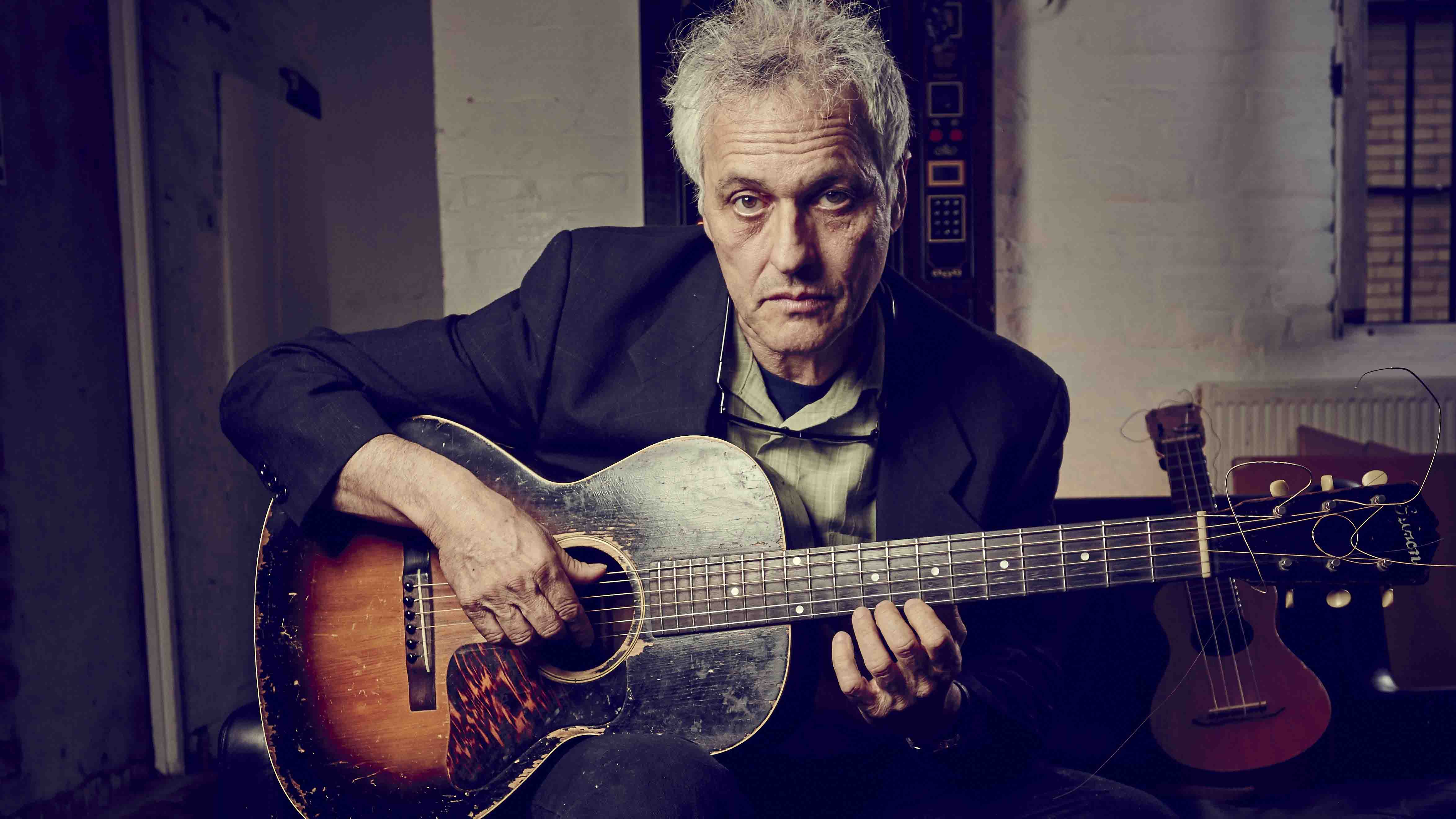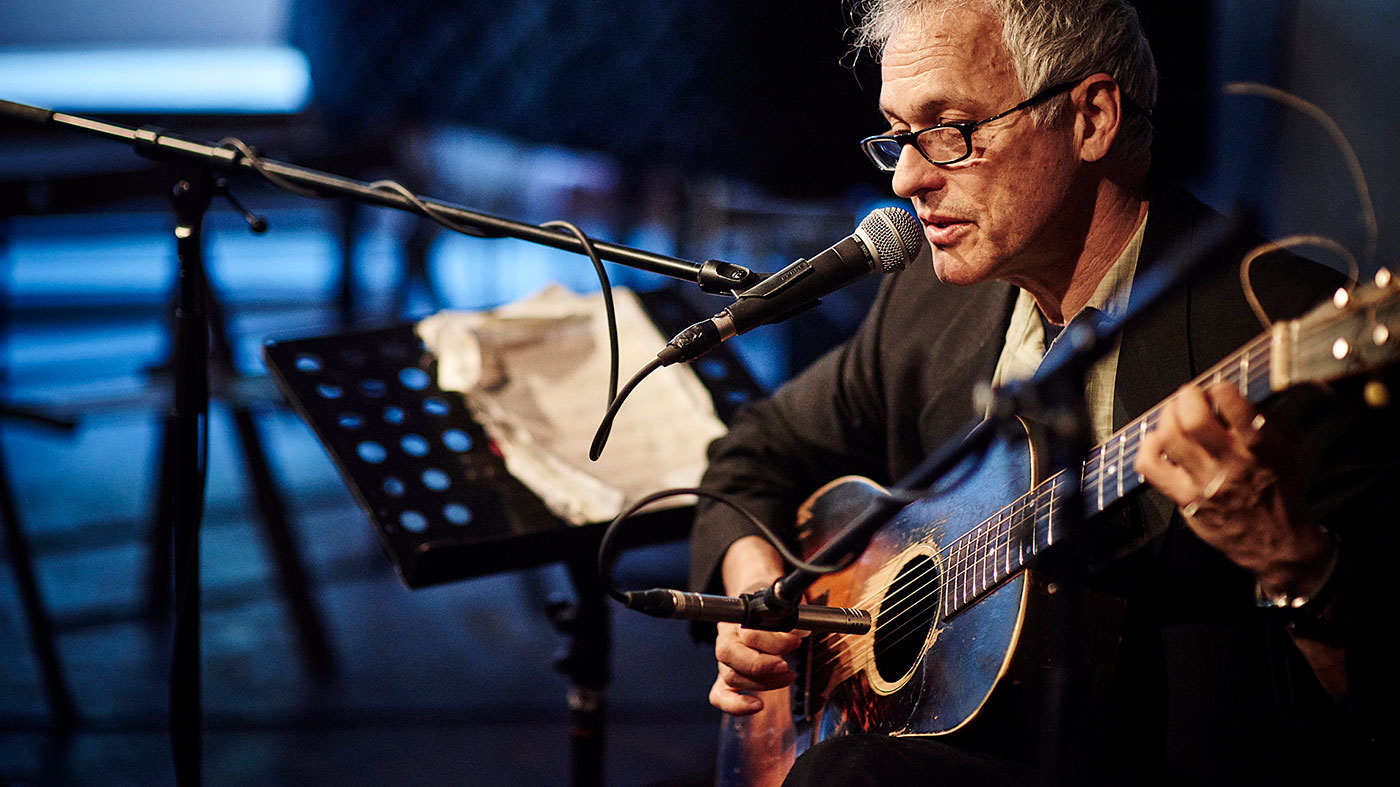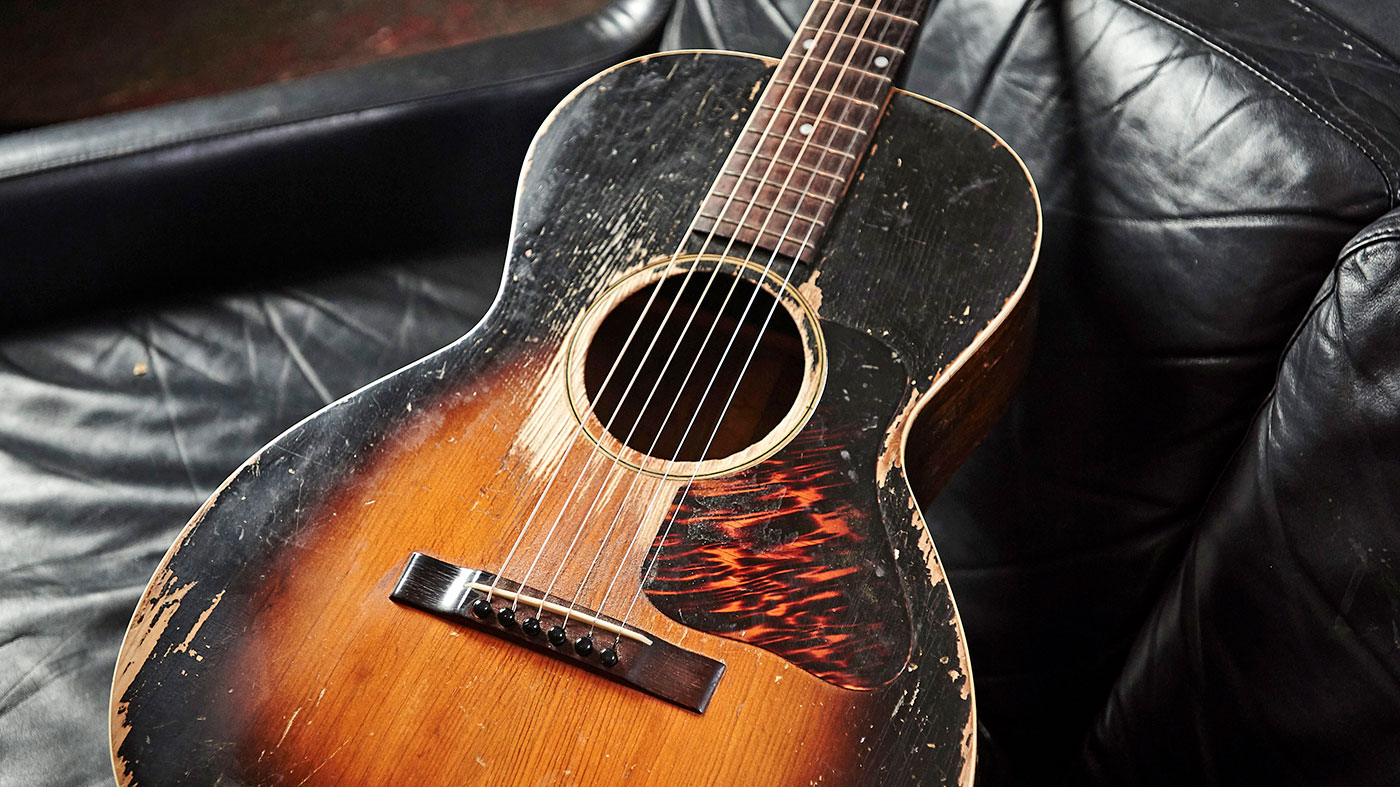Marc Ribot: “It's good to understand not only how to play guitar, but also why to play guitar”
Wisdom from the inimitable sideman to Waits, Costello, Ginsberg and Plant

With further albums in the pipeline adding to an already extensive and creatively divergent back catalogue of music, Brooklyn’s finest shares an audience with Guitarist before a sell-out London show.
Marc Ribot is travelling light. Currently halfway through a solo tour that will end in Shenzhen, China, he pulls up outside Cafe Oto in Dalston carrying a battered old Gibson acoustic and a requinto jarocho, an exotic four-string instrument not entirely dissimilar to a ukulele. It might not be an obvious choice for a guitarist, but then Marc is anything but predictable.
Since his genre-defying session work with Tom Waits in the '80s, his unparalleled style has augmented the recordings of a diverse host of artists including John Zorn, The Lounge Lizards, Elvis Costello, Robert Plant and Alison Krauss, The Black Keys, Marianne Faithfull and Beat Generation poet, Allen Ginsberg.
Tonight’s gig, however, is a truly solo affair - just one man and his guitar (or, possibly, a requinto jarocho) - and a lavishly stark insight into one of our most prolific musical pioneers whose multiple collaborations and solo releases have placed him firmly in the avant garde.
We order, then pull up a chair, while Marc whips through a few minimal requests with the front of house engineer before soundcheck: “I need one chair, a music stand and if possible a guitar stand as well… No amp - all acoustic… Mostly due to my laziness, I must say.”
This seems like a bit of a departure from your trusty ’63 Fender Jaguar!
“Yeah, that’s right! Two great years for those: ’62 and ’63 - flat pickups and chunkier necks. That’s what I kinda like. I started out on classical and I always liked bigger necks. What’s drawn people back a lot from Jaguars, especially those years of Jaguars, is the bridge, which is so impossible. I had a Mastery bridge put on - I kept it on for about five minutes and then I sent it back. I mean, it lost the funkiness, which was why I had the instrument in the first place.
Get the MusicRadar Newsletter
Want all the hottest music and gear news, reviews, deals, features and more, direct to your inbox? Sign up here.
I remember when I went away to college I had a James Brown record and a Bob Dylan record and a Django Reinhardt record
“So now I’m just used to the idea - in the middle of a solo I sometimes have to reach down and put the E string back on the E-string saddle! You have little obstacles you have to work around with that guitar, but it’s the spice of life. It’s got a funky sound with that bridge.”
Is it true that you were originally classically trained as a guitarist?
“Well, I don’t wanna exaggerate that. It’s not like I was some kind of classical music prodigy or anything. It’s more like, y’know, I wanted to take guitar lessons and my parents knew a guy who was a classical guitar teacher and they said, ‘Okay!’ He was our friend. He was classical and I wanted to play rock ’n’ roll, but he was a friend of the family, so… By an enormous piece of luck he was Frantz Casseus, the father of Haitian classical guitar. So he was very hip in terms of what he was composing and playing.
“He was strictly classical - I mean, he didn’t improvise at all, but what he was playing was deeply influenced by traditional Haitian rhythms and he also had a nice record collection that included some Django Reinhardt, so I was listening to Django Reinhardt. I remember when I went away to college I had a James Brown record and a Bob Dylan record and a Django Reinhardt record.”

Rock 'n' roll soul
What got you into rock ’n’ roll?
“When I was a teenager, what got me into rock ’n’ roll was listening to the radio. I was inspired by all the music that was on the radio in the late 60s, which was a lot! But it needs to be said that the radio where we were at the time [New Jersey] was not as micro-marketed as today and not quite as racially segregated as a result.
“So Wilson Pickett, Otis Redding and Carla Thomas would be on the same radio station as The Rolling Stones and Jefferson Airplane. Really, The Rolling Stones got me into rock ’n’ roll and also going to a local dance - there was a local band called The Chewed Roots [laughs]. They were like The Rolling Stones imitators. Y’know, I could see all the chicks dug ’em, so I thought ‘Hey, maybe there’s hope for me!’
This didn’t come out of an attempt to sound different. I sound different for a number of reasons, many of which are accidental
“Later on I realised that if your motivations were romantic then it didn’t have as much to do with what you played or how you played, but how low you wore your guitar. Like Keith Richards always wore his around his knees, and I’m sure that worked very well. But if you were classically trained and you wanted it up high, that didn’t work well at all - as I discovered. Frantz Casseus realised very early on that I wasn’t serious about classical music and didn’t make much of an effort to teach me any kind of technique, which was very wise.”
What advice do you have for guitarists who would really like to break the mould stylistically and define their own sound?
“I understand that I sound different, but this didn’t come out of an attempt to sound different. I sound different for a number of reasons, many of which are accidental. I’m left-handed but I play right-handed, so I couldn’t play nearly as fast as anyone else, which meant I had to develop a certain amount of economy and therefore I gravitated towards players that had a lot of economy, like Chuck Berry. Blues players like BB King - master of economy. People who get a lot out of a few notes, y’know? And later on to guitarists like Hubert Sumlin. And Keith Richards - a very economical player.
“I’m also a big believer in being literate. If you’re gonna call yourself a rock guitarist, you really should have spent some time memorising some of Chuck Berry’s solos, and it wouldn’t hurt to have learned some Ike Turner solos. In other words, be aware of the instrument that you’re playing. I mean, if you’re a working guitarist today, you should know who Derek Bailey was and have understood how he played. If you’re a musician you’re also an artist and it’s not bad to understand what other artists, painters and poets of your time and place are doing and thinking - what they’re dealing with, y’know?”

The best minds of my generation...
What was it like working with the Beat Poet Allen Ginsberg?
“Allen Ginsberg was great to work with. The Beat Poets and Allen definitely admired musicians almost too much, to the point where Allen was willing to place his complete trust in almost whatever musician he was working with. That said, it was wonderful working with him. I’d admired him since I was a teenager.
I think it’s a good thing to understand not only how to play guitar, but also why to play guitar and why to make art
“In fact, I’d heard him read when I was about 16. He read Kaddish, which is one of his heaviest poems - maybe his heaviest poem. And also it’s one that dealt with the lobotomy and death of his mother. The poem ends with the words ‘caw caw caw’. It’s similar in a way to Van Gogh’s suicide painting with crows [Wheatfield With Crows]. He’s intoning that. And I understood and I said, ‘Oh my God - this is what it’s about!’
“So I think it’s a good thing to understand not only how to play guitar, but also why to play guitar and why to make art. And you understand that by talking with and finding out what issues are affecting other artists. Some of them are philosophical, some of them are political. It’s good to be literate in these things as well.”
To what extent have you been able to draw inspiration from musical sources aside from guitar players?
“Actually, I’ve gotten most of my inspiration from saxophone players like [John] Coltrane and [Eric] Dolphy, but Albert Ayler in particular. He was definitely an enraged punk-rocker of the saxophone. More than that he brought it to a religious intensity. What he was doing was common to the best rock show I’ve ever been at, in that he was trying to create a ritual - an event right there for the people. Right there, a ritual that would bring them to create a deep emotional response, or a visceral response.”
So how did you interpret Tom Waits’ musical directions in order to come up with the goods?
“One of the most interesting directions was when I started to play in the style that I had used previously and he said, ‘The minute that people know what something is they stop listening.’ In other words, play what the song needs. And Waits very much thinks like a theatre director in terms of what the characters are, who the character that’s speaking is - ’cos he’s a lot of different characters, y’know - when they’re speaking and where they’re speaking. Are they whispering something in their lover’s ear? Or are they in a rowdy bar, and where is the bar? Is it in Germany in the Weimar era? Is it in Detroit?
“And each one of those different scenarios implies a different kind of guitar sound. Not only the sound, but there’s also a different kind of reverb implied. How close are you supposed to be? The way he works is he calls people who are capable of getting an understanding of his project - what he’s trying to do on each different tune. Open-mindedness is important and also a willingness to make the lyric be first. Not ‘man, I gotta do a bitchin’ solo’, you know what I mean? Because sometimes it calls for a moronic solo!”
Selected sessions
Do any of your sessions with Tom Waits stand out as personal favourites?
“The first ones, the Rain Dogs ones, were astounding. It was one of those things: the people involved, the room was great and it was my first time working with Tom. Yeah, that whole period I remember as being super-creative. He’s very creative as a producer. That was recorded in a big, old studio that doesn’t exist any more - the old RCA [Studio A] studios on 6th Avenue in New York, Midtown. We just set up in the middle of this huge room and played like a garage band [laughs]. It was really fun.”
How did you get that incredible fuzz tone on Black Market Baby?
I gotta confess two things: one is my memory is terrible, and the other is I never listen to the shit I recorded!
“I gotta confess two things: one is my memory is terrible, and the other is I never listen to the shit I recorded! So I probably haven’t heard that since I recorded it. I don’t think I even listened to the record! I dimly remember when that was going down, but I think that was the one recorded in a slightly converted chicken farm. And uhhh [laughs]… I don’t really remember much about that time!
“The tendency with Waits would be to try to really overdrive the amplifiers, but it was really fuzz. I had this weird thing that was inspired by a member of The Melvins, called the [DOD FX33] Buzz Box. At the moment, I have an Analog Man King Of Tone and I have the highest regard for that. That has served me well for many years. To be honest with you, when I got that I kind of stopped looking, because I’d been looking for years for a pedal that made a sound like an overdriven amp. That’s all I ever really wanted.”
You’ve previously spoken out against the injustices faced by musicians with regards to the internet. Are there any benefits you can think of to the way things have changed?
“No [laughs]! It’s not that I’m a Luddite, although trying to work out how to use Emagic’s Logic did ruin my life for eight or nine years. We all love the internet. We’re all using it constantly. It’s a fabulous, wonderful thing. However, musicians have been absolutely screwed by it. Not because of what it is - the way we’ve been screwed is not inherent in the technology. It’s inherent in laws that should not be there and should be taken away: the ‘safe harbour’ clause gives sites such as YouTube liability protection from third parties, even though they have the technology to protect from infringing files.
“People are eternally shocked because Google promised that all this will be the best thing that has ever happened to musicians. That’s what my ex-manager told me. These people seemed like they were seeing the future - that they could see that this was gonna be the greatest thing for the artists. But there’s one little detail that they neglected to mention: you can’t sell what people can readily get for free.”
Rod Brakes is a music journalist with an expertise in guitars. Having spent many years at the coalface as a guitar dealer and tech, Rod's more recent work as a writer covering artists, industry pros and gear includes contributions for leading publications and websites such as Guitarist, Total Guitar, Guitar World, Guitar Player and MusicRadar in addition to specialist music books, blogs and social media. He is also a lifelong musician.












